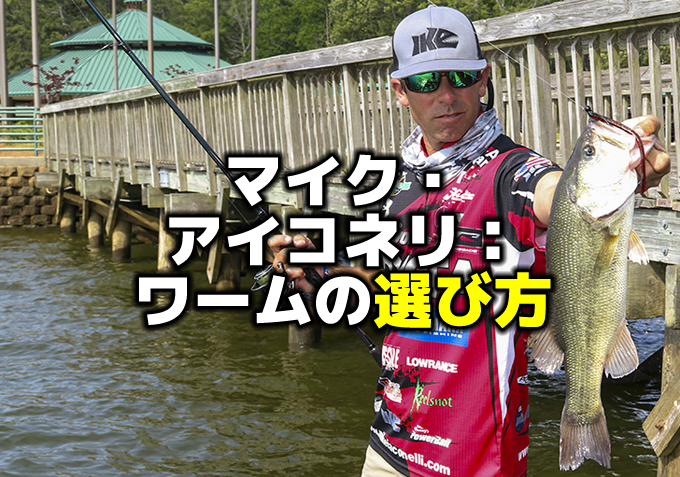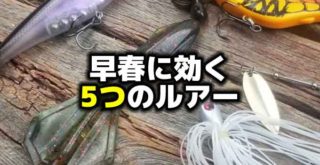釣ったバスを手にする最後の分かれ目、ランディングを極める
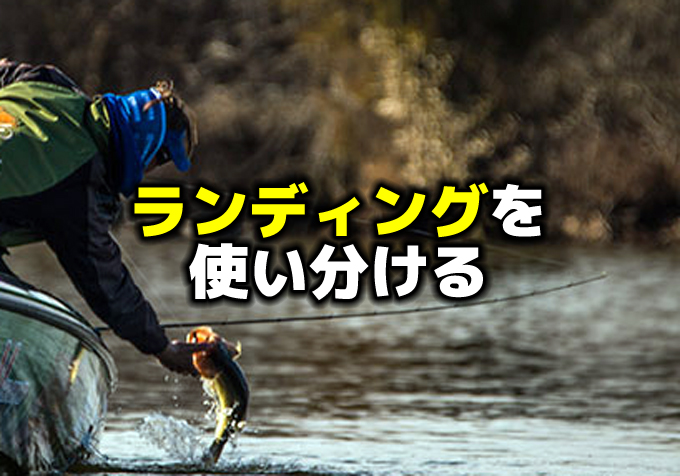
Photo by scout.com
こんにちは!店長の小山です!
本日は海外サイトより、”Are You Landing Your Bass Correctly?”という記事を引用してご紹介いたします。
引用先:scout.com”Are You Landing Your Bass Correctly?”by Walker Smith – Mar 18, 2014(海外サイトです)
バスをランディングするということ。
バス釣りの難しさにはいろいろあります。バスを見つけること、バスに口を使わせること、その日のパターンを探し出すこと…などなど。
どれも重要で難しいことには間違いありませんが、バスをランディングすることの重要性も忘れてはいけませんよね。そこまでの全てのプロセスがうまく行ったとしても、バスをランディングする段階でミスが起きることはままあることです。
あと少し、あとほんの少しというところで、バスに触れることなく、水中へお帰りいただく…
おそらく私以外にも、バスをバラした時の悔しい思い出のひとつやふたつ、お持ちの方はいらっしゃるはずです(笑)
この記事は、アメリカのフィッシングメディア「Wired2Fish」の記者、ウォーカー・スミス氏が、代表的な3つのランディング方法について長所と短所を書きだしてくれたものです。
効果的なランディング方法を学ぶことで、釣果を確実にするばかりか、危険やトラブルも回避できるということです。
ぜひ読んでみて下さい。
ランディングネット
It’s a phrase we wait all workweek to shout on Saturday mornings and, not surprisingly, it’s indicative of the most popular way of landing bass—with a long-handled net. Whether you fish from the bank or a boat, there’s a good chance you have one of these time-tested fishing tools within close reach.
Anglers often make the mistake of jabbing at the bass when netting them, but remember—this is bass fishing, not a swordfight or Live Action Role Playing. This approach is not good for two reasons—you’ll scare the crap out of the bass, causing it to flee, and you run the risk of essentially stabbing the bass off of your hooks. It’s good practice to already have the net in the water before the fish is at the surface and gently lead it into the webbing. The more you move the net, the higher chances you have of a major and potentially costly screw up.
The advantages of using a net are abundant and benefit both the fish and the angler.
- Safe on the bass—We don’t mess around when it comes to fish care. It’s the future of our sport and we’ll go to great lengths to carefully and safely release a bass back into its natural habitat. Nets are a great tool in the arsenal of fish care because there’s very little, if any, blunt force applied to the bass throughout the netting process. With the recent advancements in fishing net technology, there are also several nets on the market that don’t harm the bass’ slime coating, promoting longevity and optimal recovery.
- Large surface area—The large surface area of most long-handled nets allows for more “wiggle room” when landing a bass, especially when it’s barely hooked. These skin-hooked bass can come unbuttoned very easily with the slightest turn of their heads and nets can quickly get the fish into your boat without giving them extra opportunities to escape. Ever seen those clips of firemen catching folks who’ve jumped from a burning window? That’s how I feel when netting a bass—it’s a big safety blanket for unruly bass.
- Safe on the angler—Who wants to reach for a treble hook-laden bass mouth? I sure as heck don’t. If you’re fishing with treble hooks and notice your lure lodged sideways in a bass’ mouth, it’s not a great idea to go poking your hand around down there—I’ve learned from experience. To avoid the danger, just net them and keep your hands free of blood and holes.
There are also some disadvantages to using nets when landing bass. When used improperly, they can really break your heart.
- Treble hook nightmare—Like we discussed, there are definitely some awesome nets out there that fare much better with treble hooks, but the danger is still there. If you have a treble hooked-bass with half the bait and an entire treble hook dangling from its mouth, those exposed hooks can get caught in the net before the fish does, which almost always results in a lost opportunity. Regardless of the webbing material, sharp treble hooks can simply wrap around the strands and create a nightmare.
- Partner miscommunication—I’ve had several close calls when a fishing partner stabs at a hooked bass at the side of the boat. If you’re fishing with someone new or in a random draw tournament, I suggest either netting your own fish or considering an alternative landing method. You never know what someone else’s mistake may cost you.
- Clutter—Modern bass boats are certainly spacious, but long-handled nets seem to have a way of catching everything in the boat—line, measuring boards, culling beams, pliers—not just bass. I have an older bass boat without the fancy new net storage systems, so it’s not uncommon to see me tripping and falling over my net throughout a tournament.
私たちが仕事や学校から帰り、自宅のお風呂に浸かるとつい、「あああー…っ」という声が出てしまうものですが、同じように、柄の長いランディングネットを使用することは、最も一般的なバスのランディング方法となっています。オカッパリの釣りもボートの釣りもいずれの場合でも、長い時間にわたって証明された、釣るということを締めくくるための道具のひとつとなっています。
時々、バスに向かってネットを突き刺すように入れる間違った使い方をするアングラーがいますが、これはバス釣りであり、剣術やテレビゲームではありません。このアプローチは2つの理由で良くないことがあります。バスが怖がって嫌がることと、それによってバスに刺さっていたフックが外れて逃がしてしまう危険性があります。魚が水面に浮かんでくる前に水中にネットを入れておき、穏やかにネットに導いてあげることをお勧めします。あなたがネットを動かすほど、現実的にも潜在的にも、高い代償を払って台無しにする可能性が高くなります。
ネットを使用する利点は多く、魚と釣り人の両方にとって有益です。
- バスの安全性 – 魚のケアに関しては言うまでもありません。それはバス釣りの未来であり、私たちは慎重かつ安全にバスを元の場所へリリースするよう尽力するべきです。ネットはランディングプロセス全体を通してバスにかける力がほとんどないため、魚を扱うための素晴らしいツールです。最近のランディングネットの製造技術の進歩により、網へのラバーコーティングなど魚に害を及ぼさず、延命と回復を促進させるのに最適なネットが市場に出回っています。
- 大きな表面積 – ほとんどのランディングネットが持つ表面積の広さにより、バスをランディングさせる、特に針掛かりが浅い時などに有利となる「遊び」があります。かろうじて掛かっているようなバスはちょっと頭を振っただけで非常に簡単にフックが外れてしまいますから、ネットはバスに逃げるチャンスを与えることなくボートに魚を上げることができます。消防隊が火事で燃えている家の窓から人が飛び降りるのをキャッチするマットを見たことがありますでしょうか?バスをネットインさせるときもそんな感じなんです。あれは、窮地に追いやられたバスのための大きな安全マットなのです。
- 釣り人にも安全です – トレブルフックが付いたバスの口に手を伸ばしたいと誰が思うのでしょうか?私はそうは思えません。あなたがトレブルフックで釣りをしていて、ルアーがバスの口に横向きに刺さっていることに気づいたとき、そこへ手を差し伸べるのは良い考えではありません。私は経験から学びました。そんなときは危険を避けるためにネットに入れて、手をフックによる怪我から守ってください。
バスをランディングするときにネットを使用することによる欠点もあります。不適切に使用されると、あなたの心を折ってしまうことがあります。
- トレブルフックの悪夢 – 先に述べたように、トレブルフックを使っている時にはネットが素晴らしい役割を果たすのですが、危機はまだ去っていません。ルアーの半分だけがバスに掛かり、トレブルフックが口から下がっているバスをランディングする場合、その露出したフックを魚がネットインさせる前に網に引っ掛けてしまうと、多くの場合、バスを失います。ネットの素材や網目の大きさにかかわらず、鋭いトレブルフックは常に絶望と悪夢をはらんでいます。
- 息の合った仲間と – 連れがボートの横で釣った時、危機一髪だったことがあります。あなたが新しい仲間やトーナメントでランダムで選ばれた相手と釣っている場合は、自分で魚をネットに入れるか、別のランディング方法にすることをお勧めします。他人のミスがあなたにかからないとは決して言えません。
- 邪魔になる – 最新のバスボートは広々としていますが、デッキの上には長い柄を持つネット以外にも、係留ロープ、板メジャー、はかり、ペンチなどが置いてあるはずです。私は豪華な最新式のネットストレージがない古いバスボートなので、トーナメント中にネットを踏み潰されることも珍しくないのです。
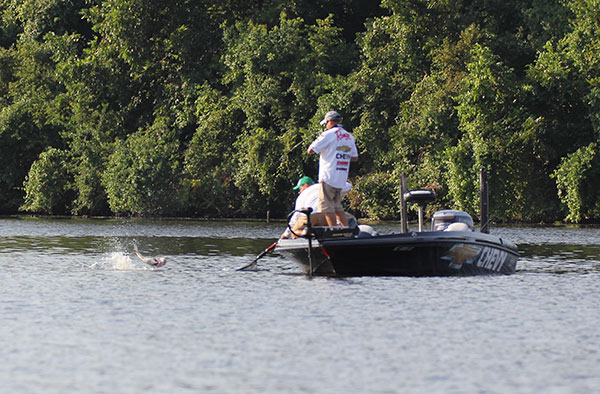
Photo by scout.com
ゴボウ抜き
Swinging or boat flipping bass is a landing method that can make you look like a hero or a real moron depending upon the results. Personally speaking, I love it and probably do it too much. But again, we’ve all been there—the half-second or second that bass is dangling in the air is one of the most nerve wracking feelings an angler can have. If it gets in the boat, watch out KVD—you’re coming. If it clumsily flops against the side of your boat and swims away, you’re wearing a dunce hat in the corner. That’s the way it goes.
Boat flipping bass takes a lot of practice and a little bit of instinct as well. Anyone can flip pecker heads into the boat, but the real challenge comes when you’re landing larger fish. If you have the bass on the surface coming towards the boat, use its momentum to gently lift it out of the water and into your hands. You’ll want to use one hand to grab your rod about five inches about the foregrip and the other hand to grab hold of the rod butt. Lift your road tip high, arch your back and avoid any sudden jerking throughout your motion.
There are certain times in which boat flipping a bass is desirable.
- Smaller bass—There’s no need to break out the net when you have a throwback on the other end of your line. It’s more work for you to manage by yourself and if you have a partner, it interrupts their cast. Someone needs to have a line in the water at all times and you’ll lose a lot of fishing time if you’re fooling around with a net when you’re catching 40 dinks a day.
- Close quarters—When I’m flipping and pitching heavy cover, I usually swing the bass into the boat as long as they’re not over five pounds. With such a small amount of line between you and the fish, a big hookset is often enough to immediately bring them to the surface. Once you have ‘em on the surface while winching them in with a high-speed reel, try to use the momentum to your advantage. If you’re cranking them out of heavy cover and let off of them at the boat, they’ll often dig towards deeper water and rip the hook from their mouths.
As fun as it may be to boat flip a bass, be cautious of its disadvantages to avoid losing big bass.
- Line failure—When you dangle a bass from a lure in mid-air, you’re putting a ton of stress on your fishing line. Although you may be using heavy line, it’s important to realize the damage a bass’ teeth can do to your line. If a bass chokes your lure, its teeth will rub against the line a few inches above your knot throughout the fight. This will cause the line to become significantly weaker and more prone to breakage, which is a major concern with this technique. You’re taking away a lot of energy absorption by swinging the fish and putting additional stress on your fishing line.
- Rod failure—I kind of have a general rule in place when boat flipping bass. I’m a cranker and flipper, so I’ll boat flip a bass up to three pounds with my cranking rods and flip bass up to five pounds with my really heavy flipping rods. There are times, however, when I’ve snapped a rod in half with this method. Whether it’s because you misjudged the fish initially or grabbed too far up on the rod blank, this is a serious possibility, so be warned.
- Fish care—Every time I swing a bass into the boat, I make a concerted effort to grab the line before the fish touches the carpet—the technique that has been made popular by Major League Fishing. There’s always a possibility, however, that the fish can come unbuttoned and flop onto your boat carpet. This is a bad situation for two reasons—the carpet removes their slime coating and can inhibit their ability to quickly recover and the bass can also bounce back into the water. Either way, you don’t want this to happen. If it’s barely hooked or you don’t feel comfortable in your boat flipping technique, break out the net and play it safe.
バスをゴボウ抜きにすることは、見方によってはあなたを英雄のように見せることができるランディング方法です。個人的には、私も好きですし、結構やっています。しかし、よく考えてみると、バスが空中にいるその0.5秒から1秒の間、釣り人として心を痛める感情はないでしょうか。ボートに入れるときは、KVDだろうが誰だろうが気を付けるべきです。もし引き抜いたバスをボートの角にドンと当ててしまってまた泳ぎ出すようなことになれば、あなたは申し訳ない気持ちになるでしょう。それは当然の成り行きです。
バスのゴボウ抜きは、多くの練習とわずかな直感が必要です。たいしたことのない魚なら誰でもゴボウ抜きでボートに入れることができますが、大きな魚をランディングするとなると結構な挑戦になります。バスがボートの方に向かってきている場合は、その勢いを使って静かに水から持ち上げ、手にしてください。片方の手でフォアグリップを握り、もう一方の手でロッドのバット部分をつかむといいでしょう。ロッドティップを高く持ち上げ、背中を伸ばして、一連の動作のなかで急に引き抜くことの無いようにしてください。
バスをゴボウ抜きにする方が好ましい場合があります。
バスが小さい – バスが全然引かない時はネットを使う必要はありません。1人でできるのであればそれはありがたいことです。連れがいる場合、キャストを中断して手伝うことになります。できれば常に誰かのラインが水中にあることが望ましく、ワームを使って1日に40匹も釣れそうだという時にいちいちネットを使っていては、多くの釣りの時間を失うことになります。
接近戦 – ヘビーカバーをフリッピングで釣っているとき、私の場合は5ポンド以上のバスでない限りゴボウ抜きにします。自分と魚との間にあまり距離がないならば、大きなフッキング動作そのものが充分にバスを表層まで持ち上げることができます。ハイスピードリールを使用してバスを水面を滑らせるように巻いてきて、その勢いを利用してみましょう。うまいことヘビーカバーから引き剥がさないと、ボートから遠ざかってしまい、だいたい深い方へ潜られてフックを外されてしまうでしょう。
バスをゴボウ抜きにするのは気分がいいからといって、ビッグバスを失うことの無いよう、次のことには注意してください。
ラインの不具合 – 空中でルアーとバスをぶら下げるということは、ラインにストレスがかかるということです。太いラインを使用しているかもしれませんが、バスの歯があなたのラインにダメージを与えているということを理解することが重要です。バスがあなたのルアーを丸飲みした場合、その歯によって、やり取りのなかで結び目の数センチ上のラインが擦れます。これにより、ラインが著しく弱くなり、切れやすくなりますが、これがこのテクニックの大きな懸念材料なのです。あなたが魚を左右にいなしている間も、多くのエネルギーがあなたのラインにさらなるストレスをかけています。
ロッドの不具合 – 私がバスをゴボウ抜きでランディングしようとするとき、あるルールを持っています。私はクランカーでありフリッパーなのですが、クランク用ロッドは3ポンドまで、フリッピングロッドはヘビーロッドなので5ポンドまでなら抜き上げられます。しかし、この方法でロッドを半分に折ってしまったことがあります。魚の重さを見誤ってしまったのか、ロッドのブランクのあまりにも先の方を持ってしまったのか分かりませんが、こういう重大な事が起こる可能性がありますので、注意してください。
魚のケア – 私がボートにバスを抜き上げるたびに、魚がカーペットに触れる前にラインをつかむよう努力しています。これはメジャーリーグフィッシング(アメリカの釣り番組)で人気のあるテクニックです。しかし、魚がボートのカーペットにドスンと落ちてしまう危険が常にあります。これは、2つの理由から悪い状況になります。カーペットは、魚の粘膜を取り除いてしまい、バスがすぐ回復する能力と水に戻っていく能力を阻害してしまう可能性があります。いずれにせよ、あなたもこれが起こることを望んでいないはずです。かろうじてフックが刺さっているようなときや、またはゴボウ抜きするのが好きではない場合は、ネットを使って安全にプレイしてください。
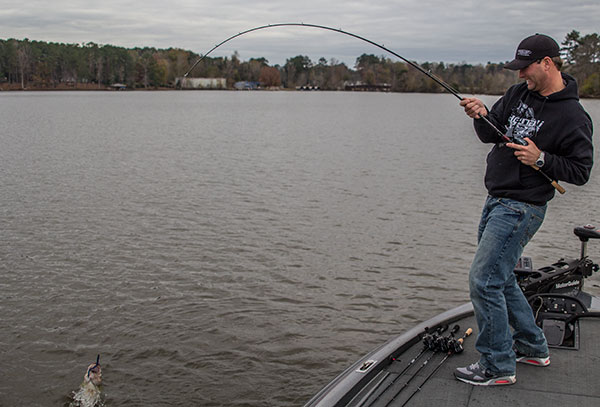
Photo by scout.com
手ですくう、腹を抱く
When watching professional fishing, you’ve probably seen a lot of the Elite Series anglers belly landing fish, especially smallmouth bass. This can be for a multitude of reasons, but it’s often because they’re using extremely light line with small, lightwire hooks.
If you don’t mind getting your shirt sleeves and torso drenched in water, this is a solid landing technique that’s outstanding for landing large bass on light line. Slowly fight the fish all the way to the boat, wear it down and lead the bass into the palm of your submerged hand with your rod tip. Be careful not to squeeze its belly and cause injury—simply cradle it and quickly scoop it into the boat.
Belly landing bass is advantageous for several reasons, but it requires more practice than most landing methods.
- Skin-hooked bass—If you have a single hook hanging onto a small piece of skin in the bass’ mouth, belly landing is the way to go. For reasons we discussed earlier, a net can snag on exposed hooks and boat flipping them is far too risky. This is a fairly delicate technique, so there’s (usually) not much splashing and flopping around.
- Light line—We touched on it earlier, but we’ll quickly hit it again. A lot of folks catch giant bass on six and even four-pound line and you can’t afford to be prodding them with a net or swinging them into the boat. Even the smallest headshake from the bass can cause it to escape, so you have to be very slow and deliberate when landing a bass on light line. You could try to grab the bass by its mouth, but this technique gives you much more room to operate without making a big mistake.
- Relaxes them—I’m no fisheries biologist, but for whatever reason, when you lightly hold a bass under its belly, they become relaxed. They quit shaking and moving and just chill out. This is definitely what you want when landing a bass. The less they freak out, the better chance you have of catching them, taking a photo and safely releasing them.
Although the belly landing technique is a favorite of many anglers, be cautious of its disadvantages in certain situations.
- Cold weather—if you’re catching smallmouth bass in 40-degree water temperatures, you may not be too keen on the idea of drenching your arms up to the elbows. This definitely happens sometimes when the bass spook from the sight of your hand in the water, so think twice before turning into a human Popsicle for the rest of the day.
- Slippery little boogers—Bass can be hard enough to get ahold of in your livewell, so imagine trying to grab a mad 3-pounder out of a lake—it’s pretty dang tough sometimes. This technique definitely requires practice because it’s not too hard to lose your grip on a good fish and watch it swim away.
- It can hurt—More often than not, belly landing bass requires lying down on your carpet and reaching over the side of your boat. I can’t tell you how many times I’ve jabbed my ribs with reel handles, hooked my arms in crankbaits and laid my leg on top of a lava-hot metal latch when doing this. It sounds kind of funny, but I’m being serious—you can hurt yourself doing this, so just be careful when deciding where to belly land your fish.
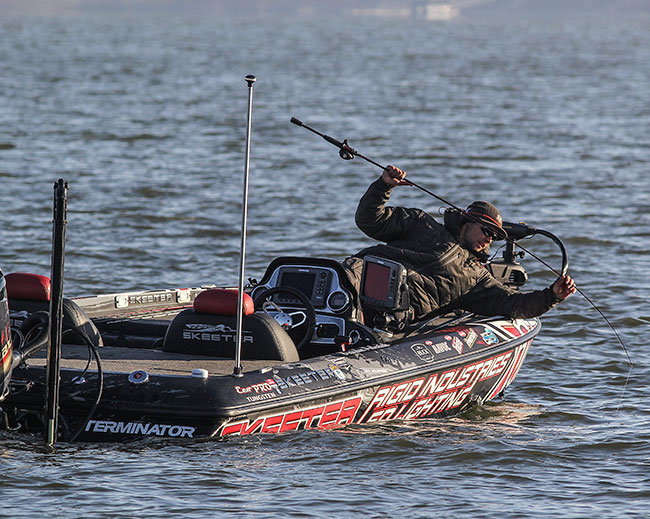
Photo by scout.com
エリートシリーズのプロの釣りを見ていると、アングラーたちが魚をキャッチする場面、特にスモールマウスバスでのベリーランディング(バスのお腹を抱えるランディング方法)の場面を多く見たことがあるでしょう。これはさまざまな理由が考えられますが、主に細いワイヤーフックと非常に細いラインを使用していることが多いためです。
シャツの袖や身体が水に濡れてしまっても構わなければ、これはライトラインで大きなバスをランディングする際に確実で優れたテクニックです。ゆっくりとボート上で魚とファイトし、体力を使わせ、ロッドティップを使って水中の手の方へバスを誘導します。腹を握りつぶさないように注意してください。やさしく抱きかかえてすぐにボートに乗せてください。
ベリーランディングはいくつかの理由から望ましいのですが、他のランディング方法より多くの練習を必要とします。
皮一枚で掛かっている場合 – バスの口元にある皮に1本のフックだけが掛かっている場合は、ベリーランディングが有効です。前述した通り、ネットでは露出したフックが引っ掛かってしまうことがありますし、ゴボウ抜きなんてもってのほかです。これはかなりデリケートに行いますので、通常はあたりに飛び散ったりドスンと落としてしまうことはありません。
細いライン – 先に軽く触れましたが、あらためてご説明します。多くの人が6ポンドや4ポンドのラインで巨大なバスを捉えたとき、ランディングネットでバスを怖がらせたくありませんし、ボートに抜きあげる強度もありません。バスのちょっとのヘッドシェイクでも逃げられる可能性がありますので、ライトラインでバスをランディングするときは非常にゆっくりと、慎重にしなければなりません。バスの口をつかむことはできますが、このテクニックでは大きなミスを犯さずに行える余地がもっと大きいのです。
リラックス – 私は魚類の生物学者ではありませんが、理由はどうあれ、腹の下を軽い力でバスを持つと、リラックスした状態になります。彼らは暴れたり動きまわったりするのをやめ、おとなしくなります。これは間違いなくバスをランディングさせるときに必要な状態です。彼らが気に触ることが少ないほど、あなたはバスをつかまえ、写真を撮って安全にリリースするチャンスが得られます。
ベリーランディングテクニックは多くの釣り人が好んで使用されますが、特定の状況では不利に働くことがあることに注意してください。
寒い天気 – 水温4℃でスモールマウスバスをランディングするとき、いくら夢中になっているとはいえ腕を肘まで濡らすということは良くないかもしれません。バスが水中であなたの手を発見して怯えてしまうこともありますし、びしょ濡れの腕が段々とアイスキャンディーのように凍ってしまう前に1度考えてみてください。
滑ったら最悪 – ライブウェルにいるバスを捕まえるのでさえ結構難しいことなのに、怒っている3パウンダーを湖から抱き上げることを想像してみてください。このテクニックは間違いなく練習を必要とします。なぜなら、グッドフィッシュが手から滑り落ちて泳ぎ去っていくのを見ることはそう難しくないからです。
怪我をする可能性があります – だいたい、ベリーランディングしたバスはまずカーペットの上に横たわらせてから、あなたがボートを横に回ってバスに手を伸ばす必要があります。これをしようとするとき、(デッキに置いてあるロッドについてる)リールハンドルが肋骨にめり込んだり、クランクベイトが腕に引っ掛かってきたり、溶岩のように熱くなったクリート(ボートの金属パーツ)に脚を置いてしまったことが何度あったかわかりません。笑い話に聞こえるかもしれませんが、私には深刻です。あなたは自分自身を傷つけてしまう可能性があるので、魚をどこに寝かせるべきか、決めるときは注意してください。
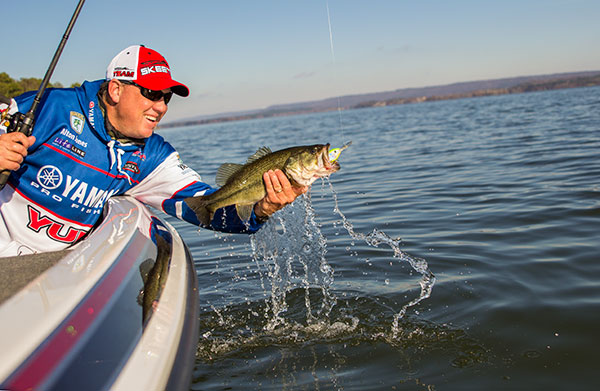
Photo by scout.com
いかがでしたか。
あらためて「ランディング」ということを掘り下げてみただけで、これだけの特徴、それから長所や短所が出てくるものなんですね。
私の場合は趣味の範囲ですから、トーナメンターさん方よりは魚のダメージに対して神経を使うことはないのかもしれません。
しかし私のようにあくまでも趣味の範囲の方が多いとは言え、この趣味を長く、正しく続けていくために、バスは限りある資源なんだと思えば、バスのダメージに配慮することが必要という考えに行きつくはずです。
いえ、これを読んでいる皆さんの多くはもうとっくにそうお考えかと思います。
ただ、人間のやることですから、好きとか嫌い、かっこいいとかカッコ悪いという感情は必ずありますし、そういう感情が強い時期は誰にだってあると思います。ですので、決してバスファーストとは言えないランディング、または敢えて危ういランディングをしてしまったって、それはそれでいいと思います。
この記事はそんな誰かを悪者にしたり、笑ったりする基準になるものではありません。
この記事を読んでいなくたって、どこかでランディングの色んな方法や長所短所を知って、危険な目に遭ったり様々な体験や経験をして、最終的にバスや自分を大事にする方法をチョイスするようになればそれでいいのではないかと思います。
知らない人は知らないだけなので、仲のいい人には教えてあげてもいいのかもしれません。
しかし、あの時にバラした多分自己最高記録のスモール、あれがなんでバレたのか、いまだに納得できないんですよねえ(笑)
もっと早くランディングネット買っておけばよかったんでしょうねえ(笑)
皆さんも、お気をつけて。
それでは、また。
毎度ありがとうございます!
記事中にはリリース推奨とされていますが、これはあくまでもアメリカの記事を翻訳したものです。私といたしましてもバスへのダメージは最小限に抑えたリリースをしておりますが、日本国内においては、その地域やフィールドのルールを遵守されますよう、お願いいたします。






